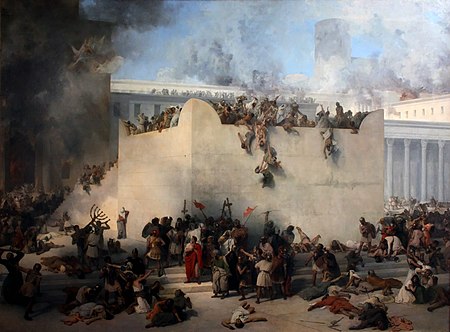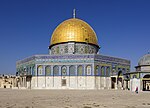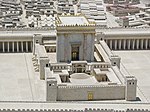Siege of Jerusalem (70 CE)

The siege of Jerusalem of 70 CE was the decisive event of the First Jewish–Roman War (66–73 CE), in which the Roman army led by future emperor Titus besieged Jerusalem, the center of Jewish rebel resistance in the Roman province of Judaea. Following a five-month siege, the Romans destroyed the city and the Second Jewish Temple.In April 70 CE, three days before Passover, the Roman army started besieging Jerusalem. The city had been taken over by several rebel factions following a period of massive unrest and the collapse of a short-lived provisional government. Within three weeks, the Roman army broke the first two walls of the city, but a stubborn rebel standoff prevented them from penetrating the thickest and third wall. According to Josephus, a contemporary historian and the main source for the war, the city was ravaged by murder, famine and cannibalism.On Tisha B'Av, 70 CE (August 30), Roman forces finally overwhelmed the defenders and set fire to the Temple. Resistance continued for another month, but eventually the upper and lower parts of the city were taken as well, and the city was burned to the ground. Titus spared only the three towers of the Herodian citadel as a testimony to the city's former might. Josephus wrote that over a million people perished in the siege and the subsequent fighting. While contemporary studies dispute this figure, all agree that the siege had a major toll on human life, with many people being killed and enslaved, and large parts of the city destroyed. This victory gave the Flavian dynasty legitimacy to claim control over the empire. A triumph was held in Rome to celebrate the fall of Jerusalem, and two triumphal arches were built to commemorate it. The treasures looted from the Temple were put on display.The destruction of Jerusalem and the Second Temple marked a major turning point in Jewish history. The loss of mother-city and temple necessitated a reshaping of Jewish culture to ensure its survival. Judaism's Temple-based sects, including the priesthood and the Sadducees, diminished in importance. A new form of Judaism that became known as Rabbinic Judaism developed out of Pharisaic school and eventually became the mainstream form of the religion. Many followers of Jesus of Nazareth also survived the city's destruction. They spread his teachings across the Roman Empire, giving rise to the new religion of Christianity. After the war had ended, a military camp of Legio X Fretensis was established on the city's ruins. Jerusalem was later re-founded as the Roman colony of Aelia Capitolina. Foreign cults were introduced and Jews were forbidden entry. This event is often considered one of the catalysts for the Bar Kokhba revolt.
Excerpt from the Wikipedia article Siege of Jerusalem (70 CE) (License: CC BY-SA 3.0, Authors, Images).Siege of Jerusalem (70 CE)
Heil HaHandasa, Jerusalem Morasha
Geographical coordinates (GPS) Address Nearby Places Show on map
Geographical coordinates (GPS)
| Latitude | Longitude |
|---|---|
| N 31.778055555556 ° | E 35.235833333333 ° |
Address
העיר העתיקה בירושלים וחומותיה
Heil HaHandasa
9511208 Jerusalem, Morasha
Jerusalem District, Israel
Open on Google Maps










